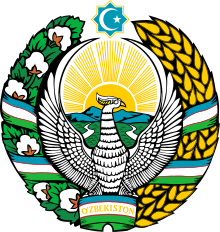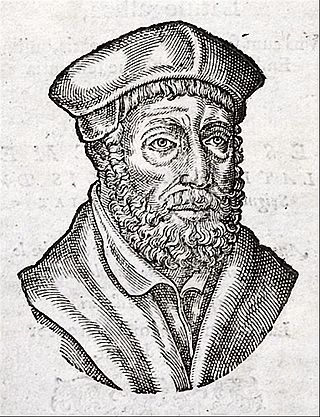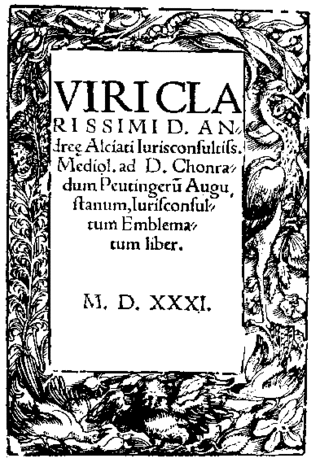


An emblem is an abstract or representational pictorial image that represents a concept, like a moral truth, or an allegory, or a person, like a monarch or saint. [1]



An emblem is an abstract or representational pictorial image that represents a concept, like a moral truth, or an allegory, or a person, like a monarch or saint. [1]

Although the words emblem and symbol are often used interchangeably, an emblem is a pattern that is used to represent an idea or an individual. An emblem develops in concrete, visual terms some abstraction: a deity, a tribe or nation, or a virtue or vice.[ clarification needed ]
An emblem may be worn or otherwise used as an identifying badge or patch. For example, in America, police officers' badges refer to their personal metal emblem whereas their woven emblems on uniforms identify members of a particular unit. A real or metal cockle shell, the emblem of James the Great, sewn onto the hat or clothes, identified a medieval pilgrim to his shrine at Santiago de Compostela. In the Middle Ages, many saints were given emblems, which served to identify them in paintings and other images: St. Catherine of Alexandria had a wheel, or a sword, St. Anthony the Abbot, a pig and a small bell. These are also called attributes, especially when shown carried by or close to the saint in art. Monarchs and other grand persons increasingly adopted personal devices or emblems that were distinct from their family heraldry. The most famous include Louis XIV of France's sun, the salamander of Francis I of France, the boar of Richard III of England and the armillary sphere of Manuel I of Portugal. In the fifteenth and sixteenth century, there was a fashion, started in Italy, for making large medals with a portrait head on the obverse and the emblem on the reverse; these would be given to friends and as diplomatic gifts. Pisanello produced many of the earliest and finest of these.
A symbol, on the other hand, substitutes one thing for another, in a more concrete fashion: [1]


A totem is specifically an animal emblem that expresses the spirit of a clan. Emblems in heraldry are known as charges. The lion passant serves as the emblem of England, the lion rampant as the emblem of Scotland.
An icon consists of an image (originally a religious image), that has become standardized by convention. A logo is an impersonal, secular icon, usually of a corporate entity.
Since the 15th century, the terms of emblem (emblema; from Greek : ἔμβλημα, meaning "embossed ornament") and emblematura belong to the termini technici of architecture. They mean an iconic painted, drawn, or sculptural representation of a concept affixed to houses and belong—like the inscriptions—to the architectural ornaments (ornamenta). Since the publication of De re aedificatoria (1452) by Leon Battista Alberti (1404–1472), patterned after the De architectura by the Roman architect and engineer Vitruvius, emblema are related to Egyptian hieroglyphics and are considered as being the lost universal language.[ citation needed ] Therefore, the emblems belong to the Renaissance knowledge of antiquity which comprises not only Greek and Roman antiquity but also Egyptian antiquity as proven by the numerous obelisks built in 16th and 17th century Rome. [4]

Evidence of the use of emblems in pre-Columbian America has also been found, such as those used in Mayan city states, kingdoms, and even empires such as the Aztec or Inca. The use of these in the American context does not differ much from the contexts of other regions of the world, being even the equivalent of the coats of arms of their respective territorial entities. [5]
The 1531 publication in Augsburg of the first emblem book, the Emblemata of the Italian jurist Andrea Alciato launched a fascination with emblems that lasted two centuries and touched most of the countries of western Europe. [6] "Emblem" in this sense refers to a didactic or moralizing combination of picture and text intended to draw the reader into a self-reflective examination of their own life. Complicated associations of emblems could transmit information to the culturally-informed viewer, a characteristic of the 16th-century artistic movement called Mannerism.
A popular collection of emblems, which ran to many editions, was presented by Francis Quarles in 1635. Each of the emblems consisted of a paraphrase from a passage of Scripture, expressed in ornate and metaphorical language, followed by passages from the Christian Fathers, and concluding with an epigram of four lines. These were accompanied by an emblem that presented the symbols displayed in the accompanying passage.
Emblems are certain gestures which have a specific meaning attached to them. These meanings are usually associated with the culture they are established in. Using emblems creates a way for humans to communicate with one another in a non-verbal way. An individual waving their hand at a friend, for example, would communicate "hello" without having to verbally say anything. [7]
Although sign language uses hand gestures to communicate words in a non-verbal way, it should not be confused with emblems. Sign language contains linguistic properties, similar to those used in verbal languages, and is used to communicate entire conversations. [8] Linguistic properties are verbs, nouns, pronouns, adverbs, adjectives, etc.. [9] In contrast with sign language, emblems are a non-linguistic form of communication. Emblems are single gestures which are meant to get a short non-verbal message to another individual.
Emblems are associated with the culture they are established in and are subjective to that culture. For example, the sign made by forming a circle with the thumb and forefinger is used in America to communicate "OK" in a non-verbal way, in Japan to mean "money", and in some southern European countries to mean something sexual. [10] Furthermore, the thumbs up sign in America means "good job ", but in some parts of the Middle East the thumbs up sign means something highly offensive. [11]

Andrea Alciato, commonly known as Alciati, was an Italian jurist and writer. He is regarded as the founder of the French school of legal humanists.

A symbol is a mark, sign, or word that indicates, signifies, or is understood as representing an idea, object, or relationship. Symbols allow people to go beyond what is known or seen by creating linkages between otherwise very different concepts and experiences. All communication is achieved through the use of symbols. Symbols take the form of words, sounds, gestures, ideas, or visual images and are used to convey other ideas and beliefs. For example, a red octagon is a common symbol for "STOP"; on maps, blue lines often represent rivers; and a red rose often symbolizes love and compassion. Numerals are symbols for numbers; letters of an alphabet may be symbols for certain phonemes; and personal names are symbols representing individuals.

Jolly Roger is the traditional English name for the naval ensign flown to identify a pirate ship preceding or during an attack, during the early 18th century. The vast majority of such flags flew the motif of a human skull, or “Death's Head”, often accompanied by other elements, on a black, dark brown or dark blue field, sometimes called the “Death's Head flag” or just the “black flag”.
Symbolic communication is the exchange of messages that change a priori expectation of events. Examples of this are modern communication technology and the exchange of information amongst animals. By referring to objects and ideas not present at the time of communication, a world of possibility is opened. In humans, this process has been compounded to result in the current state of modernity. A symbol is anything one says or does to describe something, and that something can have an array of many meanings. Once the symbols are learned by a particular group, that symbol stays intact with the object. Symbolic communication includes gestures, body language and facial expressions, as well as vocal moans that can indicate what an individual wants without having to speak. Research argues that about 55% of all communication stems from nonverbal language. Symbolic communication ranges from sign language to braille to tactile communication skills.

A gesture is a form of non-verbal communication or non-vocal communication in which visible bodily actions communicate particular messages, either in place of, or in conjunction with, speech. Gestures include movement of the hands, face, or other parts of the body. Gestures differ from physical non-verbal communication that does not communicate specific messages, such as purely expressive displays, proxemics, or displays of joint attention. Gestures allow individuals to communicate a variety of feelings and thoughts, from contempt and hostility to approval and affection, often together with body language in addition to words when they speak. Gesticulation and speech work independently of each other, but join to provide emphasis and meaning.

An emblem book is a book collecting emblems with accompanying explanatory text, typically morals or poems. This category of books was popular in Europe during the 16th and 17th centuries.
A skull and crossbones is a symbol consisting of a human skull and two long bones crossed together under or behind the skull. The design originated in the Late Middle Ages as a symbol of death and especially as a memento mori on tombstones.

Usually known simply as the Emblemata, the first emblem book appeared in Augsburg (Germany) in 1531 under the title Viri Clarissimi D. Andreae Alciati Iurisconsultiss. Mediol. Ad D. Chonradum Peutingerum Augustanum, Iurisconsultum Emblematum Liber. Produced by the publisher Heinrich Steyner, the unauthorized first print edition was compiled from a manuscript of Latin poems which the Italian jurist Andrea Alciato had dedicated to his friend Conrad Peutinger and circulated to his acquaintances. The 1531 edition was soon followed by a 1534 edition authorized by Alciato: published in Paris by Christian Wechel, this appeared under the title Andreae Alciati Emblematum Libellus. The word "emblemata" is simply the plural of the Greek word "emblema", meaning a piece of inlay or mosaic, or an ornament: in his preface to Peutinger, Alciato describes his emblems as a learned recreation, a pastime for humanists steeped in classical culture.

Totenkopf is the German word for skull. The word is often used to denote a figurative, graphic or sculptural symbol, common in Western culture, consisting of the representation of a human skull- usually frontal, more rarely in profile with or without the mandible. In some cases, other human skeletal parts may be added, often including two crossed long bones (femurs) depicted below or behind the skull. The human skull is an internationally used symbol for death, the defiance of death, danger, or the dead, as well as piracy or toxicity.
Wingdings is a series of dingbat fonts that render letters as a variety of symbols. They were originally developed in 1990 by Microsoft by combining glyphs from Lucida Icons, Arrows, and Stars licensed from Charles Bigelow and Kris Holmes. Certain versions of the font's copyright string include attribution to Type Solutions, Inc., the maker of a tool used to hint the font.

Nonverbal communication (NVC) is the transmission of messages or signals through a nonverbal platform such as eye contact (oculesics), body language (kinesics), social distance (proxemics), touch (haptics), voice (paralanguage), physical environments/appearance, and use of objects. When communicating, we utilize nonverbal channels as means to convey different messages or signals, whereas others can interpret these message. The study of nonverbal communication started in 1872 with the publication of The Expression of the Emotions in Man and Animals by Charles Darwin. Darwin began to study nonverbal communication as he noticed the interactions between animals such as lions, tigers, dogs etc. and realized they also communicated by gestures and expressions. For the first time, nonverbal communication was studied and its relevance questioned. Today, scholars argue that nonverbal communication can convey more meaning than verbal communication.(no it can't)

The OK gesture or OK sign or ring gesture is performed by joining the thumb and index finger in a circle, and holding the other fingers straight or relaxed away from the palm. Commonly used by scuba divers, it signifies "I am OK" or "Are you OK?" when underwater. In most English-speaking countries it denotes approval, agreement, and that all is well or "okay". In other contexts or cultures, similar gestures may have different meanings including those that are negative, offensive, financial, numerical, devotional, political, or purely linguistic.
Gestures in language acquisition are a form of non-verbal communication involving movements of the hands, arms, and/or other parts of the body. Children can use gesture to communicate before they have the ability to use spoken words and phrases. In this way gestures can prepare children to learn a spoken language, creating a bridge from pre-verbal communication to speech. The onset of gesture has also been shown to predict and facilitate children's spoken language acquisition. Once children begin to use spoken words their gestures can be used in conjunction with these words to form phrases and eventually to express thoughts and complement vocalized ideas.
Skull and crossbones variations have been used by several military forces. The "Jolly Roger", traditionally used by pirates, has been used by submarines.
The skull and crossbones was a common fraternal motif as a symbol of mortality and warning in the late nineteenth and early twentieth centuries. The symbol was adopted, for various reasons, by many sporting teams, clubs, and societies in both America and Europe.

The Elm and the Vine were associated particularly by Latin authors. Because pruned elm trees acted as vine supports, this was taken as a symbol of marriage and imagery connected with their pairing also became common in Renaissance literature. Various fables were created out of their association in both Classical and later times. Although Aesop was not credited with these formerly, later fables hint at his authorship.
Developed by authors during Renaissance times, the story of an ass eating thistles was a late addition to collections of Aesop's Fables. Beginning as a condemnation of miserly behaviour, it eventually was taken to demonstrate how preferences differ.
Hand gestures are used in regions of Italy and in the Italian language as a form of nonverbal communication and expression. The gestures within the Italian lexicon are dominated by movements of the hands and fingers, but may also include movements of facial features such as eyebrows and the mouth. Theories persist as to the exact origin of hand gestures as a method of communication in Italy, however it is likely that they emerged through necessity as a universal, non-verbal method of communicating across different Italian local languages and dialects. Despite the majority of today's Italian population speaking Italian, hand gestures have persisted as a method of expression to accompany verbal speech in many regions of Italy.
Drysdall, Denis (2005). "Claude Mignault of Dijon: "Theoretical Writings on the Emblem: a Critical Edition, with apparatus and notes (1577)" . Retrieved 2009-05-29.